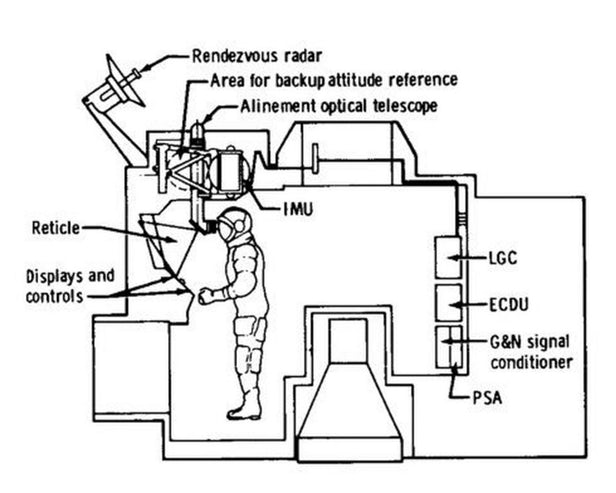Media | Articles
How AC Spark Plugs helped get Apollo 11 to the Moon and back
You probably know a bit about Apollo 11. You may not, however, know about the important role the U.S. automotive industry had getting Armstrong and Aldrin to the Moon and back.
This past Saturday marked the 50th anniversary of Neil Armstrong and Buzz Aldrin landing on the Moon, the first time humans have stepped foot on a heavenly body outside the Earth. And without General Motors’ AC Spark Plug Division’s contribution, mission commander Armstrong would have had a hard time navigating the Eagle lunar landing module safely down to the Sea of Tranquility.
I’ll get to GM’s role in a minute, but I don’t want to slight its crosstown rivals in Detroit. You’ve seen film, photos, and even movie reproductions of NASA’s Mission Control Center in Houston, Texas. NASA recently restored that historic facility. It was Ford Motor Company’s Philco-Ford electronics division that designed and built Mission Control.
Chrysler Aerospace built the Redstone rocket that launched Alan Shepard’s Mercury capsule and made him the first American to reach space. Chrysler Aerospace was also responsible for building the giant engines and first stage of the Saturn V rocket that put Apollo 11 into Earth orbit prior to traversing the quarter-million miles to the Moon.
As for General Motors, its role in the Apollo project is more than marginal. Boeing may give GM short shrift in its own accounts of the Lunar Roving Vehicle “moon buggy,” which the aerospace firm indeed constructed; however, it was the automaker’s engineers, Sam Romano and Ferenc Pavlics, who came up with the idea of the LRV in the first place, and their team was eventually responsible for its design.
Marketplace
Buy and sell classics with confidence

NASA had explored the idea of a lunar rover but had abandoned the project because their designs were too big and heavy. GM’s Romano and Ferenc figured out how to origami a functional four-wheel, electric-powered vehicle into a tiny, trapezoidal space in the Lunar Landing Module. Oh, and they made that ingenious contraption capable of carrying a half ton worth of astronauts, their space suits and gear, and whatever moon rocks and samples the crew might find necessary.
As Romano said, “I decided it can be done, it should be done, and we want to do it. If there’s going to be a vehicle on the Moon, it’s going to be a General Motors vehicle, and I’m going to make sure it happens.”
The LRV wouldn’t, however, get to the Moon until Apollo 15; and this article is supposed to be celebrating the Apollo 11 mission of Armstrong, Aldrin, and Michael Collins, who piloted the Command Module as it orbited the Moon during the landing.
So what role did GM have in Apollo 11? A big one. The automaker’s AC Spark Plug Division was responsible both for guiding Apollo 11 to Moon orbit and for providing navigation and fly-by-wire control for the Lunar Landing Module’s descent to the surface.
The AC Spark Plug Division first started working on inertial guidance and navigation systems for the United States military in the late 1940s—first on airplanes and jets, and later for missiles. It’s said that the engineers at AC were capable of guiding a Titan III intercontinental ballistic missile to a particular third story window of the Kremlin.

Small wonder that AC was contracted to help create Apollo’s guidance and navigation systems (what became known as the Apollo Guidance Computer, or AGC).The computer pioneers at Massachusetts Institute of Technology’s Instrumentation Laboratory headed the project, but AC did much of the engineering along with Kollsman Instrument Corp, leaving defense contractor Raytheon responsible for actually building the AGC.
At the time it was developed, the AGC was the most advanced fly-by-wire and inertial guidance system anywhere. It was the first digital flight computer, the first computer to use integrated circuits, and the first onboard computer used in the U.S. space effort—and the lives of the crew depended on its reliability. The engineers at AC were used to working on machinery that operated in severe environments, but potholes and road salt are nothing compared to the rigors of space flight.
The AGC turned out to be so reliable, though, that it performed nearly flawlessly in both the Command Service Module and the Lunar Module. It eventually flew on 15 manned space missions, including nine flights to the Moon, six lunar landings, three Skylab missions, and the Apollo-Soyuz test flight in 1975. The AGC was even capable of an in-flight reboot, a feature that saved the lives of the Apollo 13 crew. After an oxygen tank exploded and its mission to the Moon had to be aborted, the Apollo 13 crew conserved precious electrical power by shutting down the AGC on their return to Earth.
Without General Motors’ contribution in creating the Apollo Guidance Computer, Apollo 11 would have neither gotten to the Moon nor set foot upon it. As we celebrate Armstrong, Aldrin, and Collins’ accomplishment, let’s also remember the car guys at AC Spark Plugs who helped to get them to the Moon—and back.










